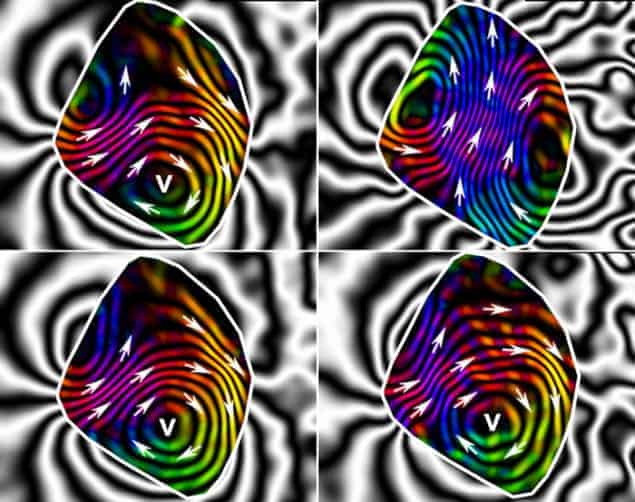
The vortex-like structures in grains of magnetite can reliably preserve magnetic information, remaining unaltered by temperature changes, thereby recording the history of the Earth’s magnetic field. That is the latest finding of researchers in Germany and the UK, who used electron holography to map the magnetic properties of individual grains. The work could help us to investigate the nature of the Earth’s magnetic field as it has evolved and changed over billions of years, as well as improve our understanding of the Earth’s core and plate tectonics.
The ability of magnetic minerals in certain rocks to capture a record of the Earth’s magnetic field at the time of their formation is a vital geological tool. Not only does it offer information on how the planetary core’s magnetic properties have changed over time, it also provides crucial evidence to support the theory of plate tectonics, showing that different continents must have moved relative to each other to explain the apparently different movements of the poles recorded by rocks across the globe.
Cool imprint
The most magnetic natural mineral is the aptly named magnetite, a commonly occurring oxide of iron. Like its other magnetic peers, magnetite typically acquires its geomagnetic imprint as it cools from molten lava. Once below its Curie temperature, tiny magnetite grains align with the Earth’s dipole. Later, this palaeomagnetic signal, which records the field intensity and direction, can be measured.
A problem when studying this rock record, however, is that not all magnetite grains are created equal, with different-sized grains adopting different magnetic domain structures based on their size. Indeed, there are three types of grains, and the smallest has long been considered “just right”. These so-called single-domain structures are magnetically near-uniform, found in grains less than 80 nm long, and are valued for their thermal stability – being able to retain magnetic signals, even if heated, over geologically useful lengths of time.
Different domains
Unfortunately, “it is only in a small part of naturally occurring magnetite that [these] magnetic structures, known for being very stable with respect to temperature fluctuations, are found”, explains physicist Trevor Almeida of the University of Glasgow, formerly of Imperial College London. Far more abundant, however, are grains of larger sizes, typically in the order of 0.1–10 μm. These form so-called pseudo-single-domain (PSD) structures, which have similar properties but are not uniform and instead often form vortex-like structures.
Despite past mathematical modelling and bulk measurements of magnetic rocks, the reliability of the signal recorded in these common pseudo-single-domain grains has remained poorly understood – until now. Almeida and colleagues have, for the first time, visualized the behaviour of PSD grains during heating. To do this, the team used an imaging method called electron holography, mapping out the vortex structures of magnetite grains of various sizes as they were heated to 550 °C – just short of their Curie temperature – and then allowed to cool.
The researchers found that while the magnetic vortices did change their strength when heated – and, in the case of the smallest PSD grains, their orientation also changed above 400 °C, adopting a lower energy state – on cooling, they returned to essentially their original state. This overall conservation of the grains’ magnetic record, in the face of the temperature change, demonstrates that the presence of PSD signals in rock does not prevent the recovery of reliable bulk palaeomagnetic information.
“These remarkable images show that vortex structures in natural magnetic systems can hold information about how the Earth’s inner structure evolved,” says team member Wyn Williams of the University of Edinburgh. He told physicsworld.com that “this is a game-changer in our understanding of rocks’ ability to act as reliable magnetic recorders, and helps us see a little clearer into the Earth’s history”.
From volcano to lab
Lennart de Groot, a geophysicist from Utrecht University in the Netherlands who was not involved in this study, says the findings are amazing and of great importance. He cautions, however, that the laboratory conditions do not entirely correspond to those found in a volcanic setting. Cooling there would not occur in a vacuum, making the grains potentially susceptible to chemical alteration. He also points out that “the grain size is rather small compared with natural igneous rocks”, adding that “larger grains can change their magnetic distribution over times of around one year; here the grains are cooled to room temperature within minutes after heating and any time dependencies on longer time scales may therefore be missed”.
Michael Winklhofer of the Ludwig Maximilian University of Munich, who was also not involved in Almeida’s work, highlights the importance of the research to the reconstruction of the ancient magnetic field from magmatic rocks. He notes, however, that the technique is limiting in that it cannot measure the out-of-plane magnetic field – meaning that it is difficult to tell whether the vortex cores are magnetized up or down, and if they stay in the same direction when heated and cooled again.
The research is described in Science Advances.



